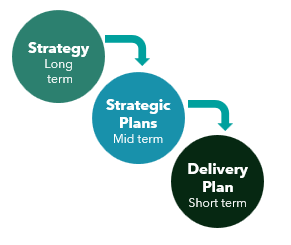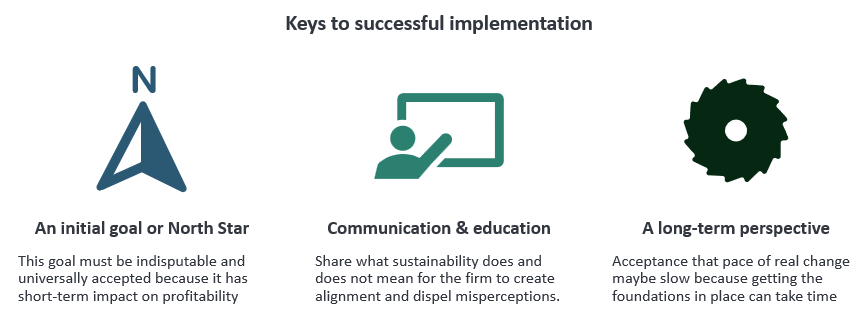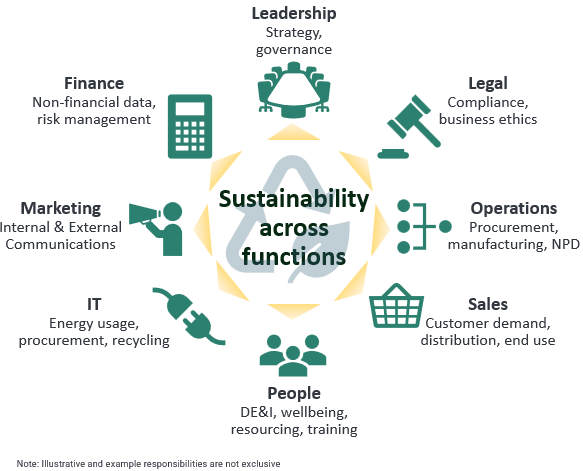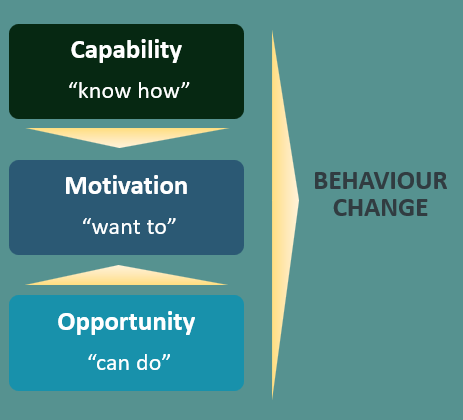To implement your sustainability strategy, what new operational capabilities do you need and who will do them?
Data. Processes. Measuring. Managing.

A delivery plan is essential to successful implementation
Once the long-term sustainability goals are set and the strategic plans created, attention must turn to the delivery plan. What key capabilities does your organisation need to achieve your ambitions, and how do you orientate your organisation towards the key execution challenges? What is the highest priority? What dependencies exist? How will you empower your staff?
This is also an opportunity to build competitive advantage into your organisational capabilities by creating processes and skills that others can’t easily emulate, and to plan for the future by horizon scanning and putting solid foundations in place.

Operational effectiveness
Embedding sustainability in Operations requires processes to collect data, manage resources efficiently, drive innovation in product design and manufacture, while considering future preparedness. Optimally, an organisation’s operations will incorporate sustainability in design, procurement, manufacturing, service provision, distribution and end use; supported by effective ESG data gathering processes, analysis and monitoring metrics.
The challenge …
To systematically embed sustainability across an organisation is a huge undertaking, and the scale of the opportunity can be overwhelming because of the need to make change happen across multiple fronts. When executing a sustainability strategy, it is commonplace to encounter misunderstanding, disagreement and inadequate progress because of other competing business priorities and attitudes.
The solution is not to be overly ambitious and to prioritise based on your strategic goals and carefully project manage the change. First, prepare the ground by deciding on an operating model and reviewing your policies, processes and talent. Next up is a prioritised project plan, with delegated ownership and a management system to ensure delivery. Remember, decarbonising Scope 3 emissions is very different to changing to reusable coffee cups.


Organisational structuring
Optimising the organisation and management structure for sustainability requires that the ownership and responsibility for sustainability be clearly defined as a functional area and embedded within other roles across the organisation. Governance structures should ensure sustainability is regularly discussed by the Board and there is consistency in the organisation’s actions, employee behaviours and reward mechanisms, aligned with the organisation’s sustainability aspirations.
The challenge …
There is no set formula for how sustainability should fit into an organisation’s structure. Where sustainability lives should be decided by where it will be most effective and this depends on the organisation’s size, its functional strengths and weaknesses, cultural attitudes and the appetite of key individuals for new responsibilities.
The solution has to be bespoke, reflecting the uniqueness of its people and organisation. Only by understanding how it functions, its various power bases, the style of leadership and existing interdependencies can it be decided where sustainability should sit organisationally. The most important consideration is being open-minded and not swayed by what you think you ought to do. The jobs should go to individuals with the knowledge and influencing skills to inspire change across functions and who are natural collaborators.

However you choose to organise the roles and responsibilities for sustainability, the fact remains that sustainability cuts across all functional areas. Invariably, a dedicated sustainability team – somewhere in the organisation – is required for knowledge and leadership, but ultimately this department may become irrelevant.
Increasingly, the Finance team is being engaged as the reporting of non-financial metrics becomes obligatory in company accounts and as the CFO generally holds considerable power in an organisation. This is seen as beneficial to progress.
For many organisations, environmental stewardship is the only aspect of sustainability that has no natural home. This makes the role of the sustainability lead as a cross-functional collaborator all the more important. See FAQs for helpful definitions.
Highlight:
Data Collection
A crucial and challenging step, not to be overlooked

Data is integral to sustainability and the data collection phase is crucial to analysis, monitoring and tracking of progress, identifying areas of improvement and driving innovation and efficiency.
Additionally (and less exciting) data is essential for meeting reporting requirements and demonstrating compliance. For example, the EU CSRD has up to 1,144 data points that companies may need to report against.
Data required for sustainability is often unstructured and scattered throughout an organisation. Its collection can present firms with a major challenge.
A sustainability journey begins with the comprehensive gathering of data: structured data from a company’s ERP and finance systems and unstructured data from teams and individuals.
If this data exists it will have been originally intended for other purposes, so likely it’ll be in the wrong format or lacking granularity or not collected at all. Data owners can lack expertise or incentives to work with the ESG agenda.
Forget buying expensive tech driven ESG data systems until you are ready for them. These are only useful if you are collecting the right data in the first place.
Highlight:
Managing change
Implementing a sustainability strategy will require behaviour change from employees. The existing organisational culture strongly influences how this change is managed, using combinations of controls and incentives. It should be phased-in by priority area, mindful of cross-functional interdependencies and include training to ensure staff know how and what to change, and that they can make those changes and are motivated to do so.
Getting this right requires evaluation of whether sufficient competency exists in current roles, or if new roles need to be created; reviews of reporting lines; new job descriptions and processes that provide assurance of effective execution.


